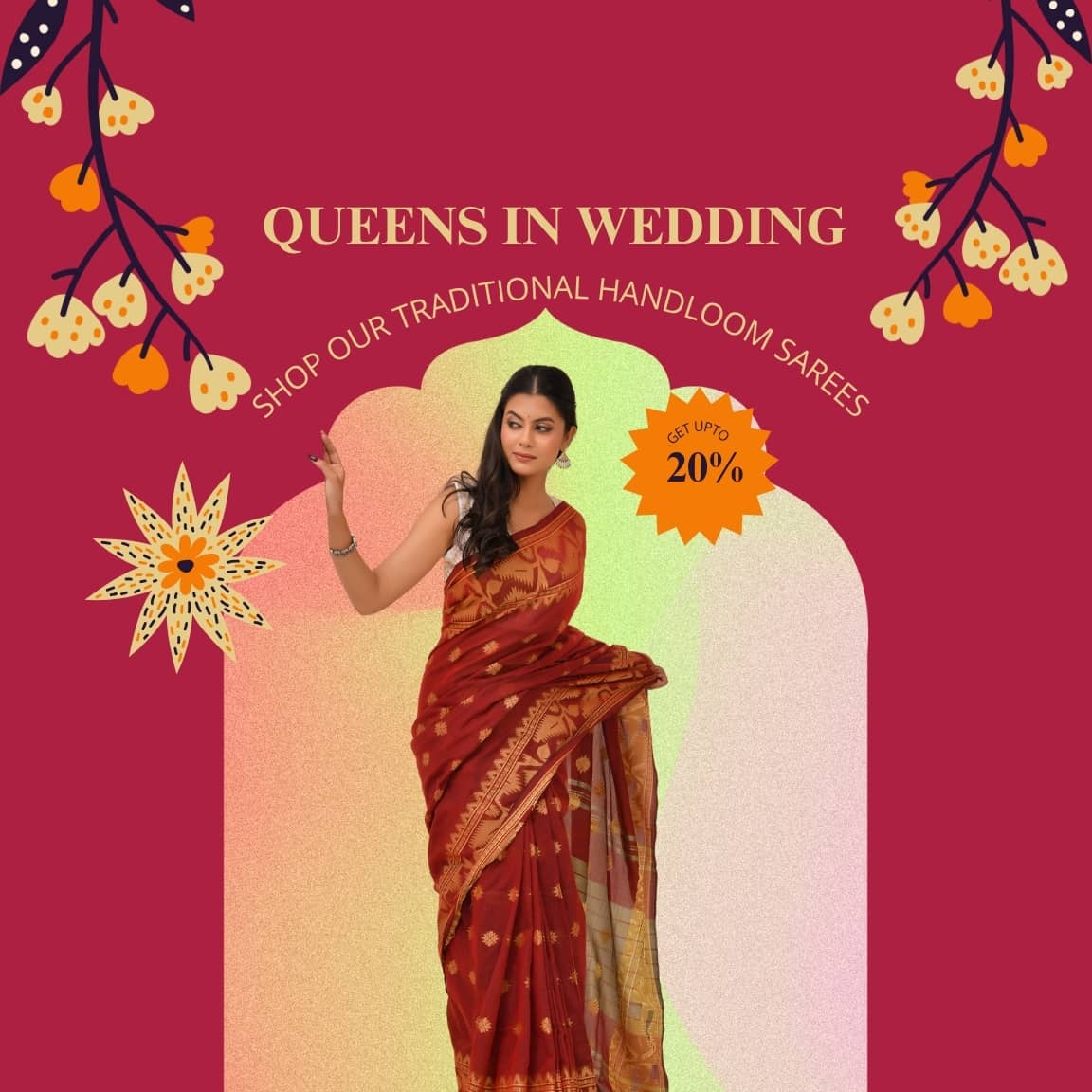The Saree That Breathes Heritage
Whenever I touch a Dhakai Jamdani saree, I can almost feel the rhythm of the loom. The softness of muslin Jamdani, the floating motifs, and the quiet patience behind every weave tell a story older than most cities we know today.
As part of my Indian Weavers Series, I wanted to share the story of Jamdani sarees - one of Bengal’s greatest contributions to world textile art. This saree isn’t just fabric; it’s poetry woven by generations of artisans who still keep this delicate craft alive in small villages across India and Bangladesh.
Birth Of Jamdani
The word Jamdani comes from Persian - “Jam” meaning flower and “Dani” meaning vase - literally, flowers in cloth.
Its birthplace was Dhaka, now in Bangladesh. During the Mughal era, Dhaka became famous for producing muslin fabric so fine it could pass through a ring - known across the world as the Muslin of Bengal. That same muslin became the base for the exquisite Dhakai Jamdani weave, where every motif is added by hand, one thread at a time.
When the Partition happened in 1947, many Bengali weavers from Dhaka migrated to West Bengal, India especially to Phulia, Shantipur, and Nadia. They brought their looms, their memory, and their art. Today, Bengal Jamdani sarees made in these Indian clusters continue the same legacy - proof that artistry transcends borders.
So yes, Dhakai Jamdani is the original Jamdani, and Indian handloom weavers are the proud keepers of that heritage.
-------------------------
The Evolution of Jamdani Weaving
The story of Jamdani sarees is one of resilience and beauty. In the 17th and 18th centuries, Jamdani was a favorite in royal courts ; adored by queens and traded across Asia and Europe. But colonial import of machine-made textiles nearly destroyed the art.
What saved it were the hands that refused to stop weaving. Generations of artisans in Bengal continued their craft, preserving the Jamdani textile - an heirloom of Indian handloom heritage.
Today, the craft has evolved beautifully:
-
Cotton Jamdani sarees for everyday elegance
-
Muslin Jamdani sarees for lightweight grace
-
Jamdani silk sarees for festive occasions and weddings
-
Soft Jamdani sarees blending comfort with heritage
Each type carries the same floating motifs, meticulous handwork, and unmistakable elegance that make Jamdani unique. See How the Authenticity looks here.
-------------------------
How a Jamdani Saree Is Made : The Art of Air and Thread
A true handloom Jamdani saree is made entirely by hand. No stencil, no print, just a graph-like pattern in the weaver’s mind. Using fine cotton or silk threads, artisans insert motifs using small bamboo sticks, one tiny thread at a time. Each saree takes anywhere from a few weeks to several months to complete, depending on the complexity of the Jamdani weave.
The result? A fabric so light it feels like air, with designs that seem to float on it. That’s the magic of Jamdani.
-------------------------
Interesting Facts About Jamdani Sarees
- “Jamdani” literally means flowers in cloth.
- The craft is recognized by UNESCO as an Intangible Cultural Heritage of Humanity.
- A single saree can take 3–6 months to weave.
- No two Jamdani sarees are ever identical.
- The traditional red and white Jamdani saree remains iconic during Durga Puja in Bengal.
-------------------------
How to Style Jamdani Sarees for Modern Occasions
Even though Jamdani sarees carry centuries of history, they blend beautifully into modern wardrobes.
-
White and Red Jamdani Saree: Pair with a red blouse for festive elegance. See in our Collection
-
Yellow Jamdani Saree with Blouse: Perfect for haldi and day events.
-
Pink or Soft Jamdani Saree: Elegant choice for office wear or cultural gatherings. Explore Here.
-
Red Jamdani Saree with Contrast Blouse: Classic for weddings and celebrations. Explore Here.
-
Jamdani Kurti or Dupatta: Ideal for those who love handloom with a modern twist.
The best part? Whether it’s a Dhakai Jamdani or a Bengal cotton Jamdani, it always stands out effortlessly.
Explore our Authentic Jamdani Bengali Sarees Here.
-------------------------
Kurja Belief
To us, a Jamdani saree is not just clothing - it’s emotion, artistry, and heritage woven together. When you drape one, you carry centuries of craftsmanship, the stories of countless Indian handloom weavers, and the quiet pride of Bengal’s artistry.
Owning one is like owning a piece of living history - and supporting the artisans who keep this timeless craft alive. Buy a Piece of Heritage Here.
At Kurja, I try to preserve this legacy by supporting the weavers who continue to create authentic Dhakai Jamdani sarees, muslin weaves, and Bengal handloom sarees.
Explore our collection of pure handwoven sarees, each one carrying the essence of Bengal’s artistry.
Explore our Collections Here. Buy Now

